Arthritis
Last updated 04-09-2025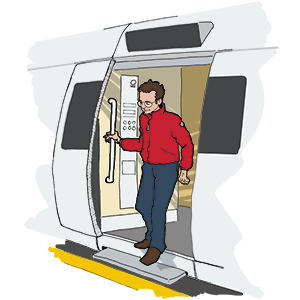 If you have arthritis, you may find that regular daily activities can be difficult to carry out. In this guide, you can read more about which assistive products may help you in your everyday life if you have arthritis.
If you have arthritis, you may find that regular daily activities can be difficult to carry out. In this guide, you can read more about which assistive products may help you in your everyday life if you have arthritis.Arthritis is the most widespread chronic disease and includes e.g., osteoarthritis, crystal arthritis , rheumatoid arthritis.
Assistive products can relieve the strain on your body and help you carry out various activities in a way where you do not use unnecessary energy on the individual activities. It may vary which assistive products can help in your situation, just as you may find that in some periods you need the assistive products and in other periods you don’t.
If you are in doubt about which assistive products will suit your needs, you can contact your local authority and let a professional make a qualified assessment, and also decide whether you could benefit from training.
Use your body properly
When you weary out or experience pain, it may be caused by your body being overloaded from not being used appropriately. It may also be caused by your environment not being optimally laid out, for instance that the table you work at is too low or too high.
By following and practicing the basic principles below, you can relieve and protect your joints. You can also get advice and guidance on how to use your body properly from a physiotherapist or an occupational therapist.
- Be economical with your strength and take breaks. When you have arthritis, you probably find that you get tired and exhausted more quickly. Therefore, make sure to distribute work tasks throughout the day or week, and take breaks along the way. Get help when possible.
- Release tension. In general, make sure not to allow too much tension in your body/muscles.
- Do not put load on your joints in their end of range position. Make sure that you only put load on the joints in the most stable position. You can do this, for instance, by using thickened grips or angled tools. You can also make sure that you have the things that you need to use within reach, so that you can reach them without making unnecessary twists in the body.
- Use the strongest joints – and ideally both hands. The smaller the joint, the less load it will stand up to. It is therefore important principally to use the larger and stronger joints when possible – and ideally both hands, so that you can distribute the load on several joints and muscles. Use for instance a drinking mug or cup with a large handle or a thermos cup that you can hold with both hands.
- Change your posture frequently. Avoid lengthy and repetitive use of the same muscles by changing your posture frequently.
- Strengthen your body through training. It is important to strengthen the muscles that work across an arthritic joint. With an individually adapted training program, you can strengthen the muscles so that the joint is stabilized and protected from harmful stress.
- Respect your pain. If you experience pain during a certain activity or posture, then stop the activity, change the posture, or take a short break. It may be that you have to find an alternative way to carry out the activity.
Orthoses
What is an orthosis?
An orthosis (bandage) is an assistive product, which supports, corrects, or relieves a body part, e.g. wrist, lower back or neck. The orthosis must be developed to support precisely the part of the body that you have problems with. Many orthoses are prefabricated and can be bought in the general trade, while others are custom made by an orthotist. Seek advice and guidance from an occupational therapist, a physiotherapist, or an orthotist in order to get an orthosis that suits you and your needs.
Pain in the hands and fingers

For pain in the hands and fingers, there are orthoses for supporting the wrist, the thumb, combined wrist/thumb orthoses and finger orthoses. In addition, there are finger splints (e.g. figure-of-eight splints) that protect the finger joints from being hyperextended.
Read more in the guide Wrist, thumb and finger orthoses.
You can also go directly to the various products in AssistData in these product groups:
Pain in the back and neck
For pain in the back there are, e.g. lumbar corsets and back corsets. For neck pain, there are soft neck collars that support and warm the neck.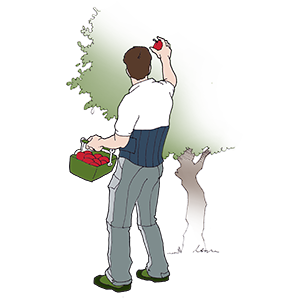
Read more in the guide Body worn assistive devices to support the back.
You can also go directly to the various products in AssistData in these product groups:
Pain in the knees
For pain in the knees, you may benefit from a knee bandage. Some of the bandages are soft and elastic and will both support your knee and keep it warm. If your knee is unstable, a bandage with braces may help. For this, however, you should get the assistance from an orthotist to choose the right bandage.
See various knee bandages in AssistData in:
Pain in the feet and ankles
If you experience discomfort or pain in your feet due to arthritis, it is important to use appropriate footwear. In AssistData you can see different types of footwear, e.g. orthopaedic footwear, insoles, foot protectors etc.
Read more in the section on shoes, boots and stockings in the guide Clothes and shoes.
Cooking and meals
There is a wide range of assistive products, which can relieve the strain on your hands and fingers – and also the shoulders – when working in the kitchen and at meals. The assistive products are typically well-known tools, but with a special design or certain properties. These utensils can be useful if, for instance, you want to avoid twisting the joints undesirably, or if you want to shift the load from small to large joints.
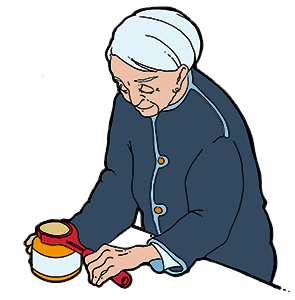
- Angled grip: An angled grip or handle (like on a saw) can prevent you from twisting your wrist undesirably and bringing it into an end of range position. You can get cutlery and kitchen utensils – but also, for instance, garden tools – with angled grips.
- Thickened grip: With an extra thick grip, e.g. on the cutlery, the load will be shifted from the small, distal joints to the larger joints in the hand. Some assistive products come with a thickened handle, but there are also separate thickened handles (grip adaptors) that you can put on your usual cutlery, and also on a pencil, a toothbrush, etc.
- Lightweight utensils: If you have reduced strength in your hands or arms/shoulders, you can go for utensils made of lightweight materials, e.g. cutlery made of lightweight metal and mugs made of plastic.
- Fixation. Assistive products that hold objects in position while you use them can be a help if you have reduced strength in your hands. It could be, e.g. cutting boards with spikes that hold the bread while you cut it.
- Alternative solutions. There are also products that allow you to carry out tasks in different ways than you usually do. It can, e.g. be a dishcloth wringer, in which the dishcloth is being wringed by simply pressing down on it. Or it could be, e.g. replacing the coffee cup with a thermal mug without a handle, so that you can hold the mug with both hands.
- Assistive products for opening packaging. A wide range of assistive products can help open different types of packaging, e.g. screw caps and medicine packages.
You can find the different types of products in AssistData in the following product groups:
- Assistive products for cutting, chopping and dividing to prepare food and drink (e.g. bread knives, kitchen scissors, cutting boards)
- Assistive products for cleaning and peeling (e.g. potato peelers, salad spinners)
- Grip adapters and attachments for cutlery, mugs, bottles, etc.
- Cutlery
- Mugs, glasses and cups and saucers
- Dishcloth wringers
- Assistive products for handling containers
Read more in AssistData’s guides:
The guide Assistive products for cooking
Bath and dressing
Different assistive products can be relevant for bathing and dressing.
Chairs and seats for the bath

There are various possibilities for sitting down while taking a bath. If you have a bathtub, you can use a bathtub board, where you sit at the height of the bathtub edge, or a bathtub seat, where you sit down in the bathtub. If you have a shower, you can use a shower stool, a shower chair, or a folding seat.
- For bathtubs: Bathtub boards and Bathtub seats
- For showering: Shower chairs with and without wheels
Read more in the guide Bath stools, bath chairs and folding shower seats for use in the shower.
Dressing
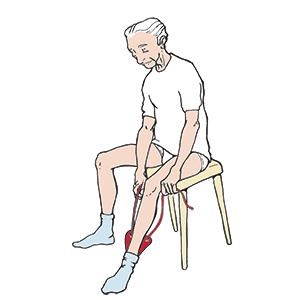
With the proper assistive products for undressing and dressing, you can reduce the strain and twisting on those parts of your body in which you have arthritis. These can be, e.g. assistive products for putting on socks, shoehorns and button hooks:
You can also read more about the various products in the guide Assistive products for undressing and dressing.
Working postures
It can be a challenge to stand up for long periods if you have pain in, e.g. your back, hips, knees, or feet. In this case, it is important to give your body a break, which you can do by carrying out the activities in a sitting position.
Activity chairs
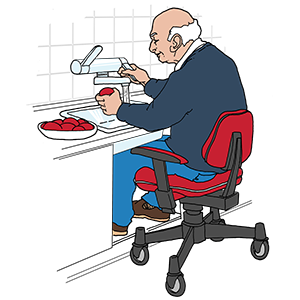
With an activity chair, you can sit down and carry out the activities you would otherwise do standing up. The activity chair can typically be adjusted so that you can tilt the seat or adjust the height of the seat to suit the situation in which you are using it. Depending on the strength in your hands, the chair is available with either hydraulic or electric height adjustment.
- Activity chairs with brake and gas spring operated height adjustment
- Activity chairs with brake and electrical height adjustment
- Standing chairs
Standing chairs
Alternatively, a standing chair where you can get relief without having to sit down completely would be more convenient for you. This may be an advantage if you also have arthritis in your knees or if, for instance, you have to knead dough or cut vegetables at the worktop. Regardless of the type of chair you choose, you must make certain that it fits into your home and the activities that you have to carry out.
Read more in the guide Activity and work chairs.
Gardening
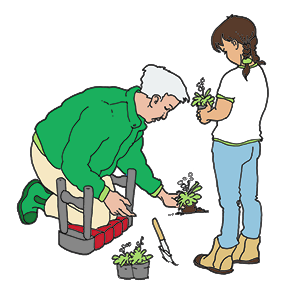
One of the places where you can typically experience challenges when you have arthritis is when gardening. It can be an advantage to acquire garden tools with anatomical or angled handles, so that you don’t overload your hands and fingers, or garden tools with a long handle if you work in a sitting position. It can also be an advantage to arrange the garden with raised beds, fences or plant towers, so that your gardening will take place in a comfortable height and without having to work in harmful postures.
You can read more about the garden tools and get good advice for working postures and arranging the garden in AssistData’s guide Gardening.
You can also go directly to the overview of all the assistive products for gardening in AssistData in:
Transportation and moving about
If you experience pain or are quickly weakened when you have to move about over long distances, there are a number of different assistive products that can provide relief. It is important that the assistive product you choose will give you precisely the support you need – no more, no less.
A professional can guide you in which type of assistive product could be relevant for you, how to use it and can help adjust the assistive products to suit your body and needs for activity.
Walking sticks
For some people, using a walking stick for support may be adequate. Walking sticks are available either as folding, non-folding sticks, or with an anatomical handle, which can be a relief for the palm. There are also forearm crutches (arthritis crutces) where you support the forearm instead of the hand/wrist. With a forearm crutch, you thus move the load away from the hand and onto the forearm.
Read more in the guide Sticks.
Rollators
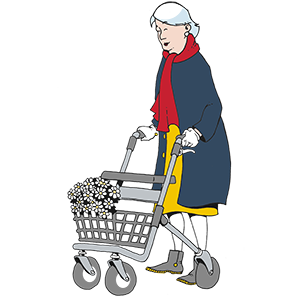
If your troubles with walking are greater, you may benefit from a rollator. Rollators are available with many different features. You should, for instance, consider whether you would primarily use it indoors or outdoors, whether it should have a seat for resting, and whether the rollator should have easy-to-use brakes in case of reduced strength in your hands. In addition, rollators are available with high forearm supports, so that you can use your forearms rather than your hands/wrists for suppert. Go to the overviews of the different rollators here:
Or read more in the guide Rollators.
Transport wheelchairs and powered scooters
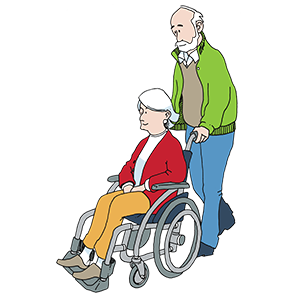 When you have to move over longer distances, you can consider a transport wheelchair where an assistant pushes you, or an electrically powered scooter, which you drive yourself.
When you have to move over longer distances, you can consider a transport wheelchair where an assistant pushes you, or an electrically powered scooter, which you drive yourself.
You can read more about what you need to pay attention to when choosing a transport wheelchair or a powered scooter in the AssistData guides:
The guide Transport wheelchairs
In the car
If you have arthritis in your knees and/or hips, it can be difficult to get in and out of the car. It may help to use a swivel cushion on the seat, so that you will have less resistance when you have to get your legs in or out of the car. In addition, an auxiliary handle that is placed in the car’s locking clamp can be a good support, because you will have something steady to lean on.
Relaxation and rest
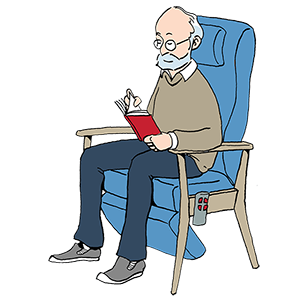
As it is particularly important for people with arthritis to rest the body to avoid overloads, it is also important to pay attention to the comfort and features of your reclining chair.
Reclining chairs are available with the option of folding the backrest back so that you can lie down, and with a foot rest so you can put your legs up. There are also recliners with built in adjustable lumbar support if you need support for your lower back. Some of the chairs are available with a lifting function, so that it is easier to sit down and get up from the chair. If you have neck problems, a reclining chair with a high back may be an option.
You can read more about what you need to pay attention to when choosing a reclining chair in the guide Reclining chairs.


